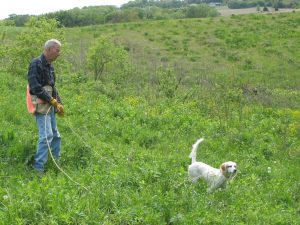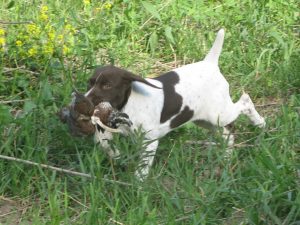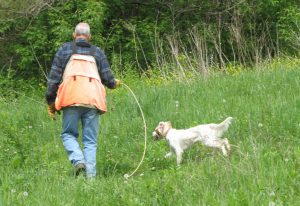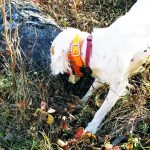Pointing Dog Pointer: The Nuts and Bolts of Starting Your Pointer Pup
by Bob and Jody Iler
“When should I start my pup’s pointing dog training?”
Our client, Joe, sat across the table from us in our office as he asked this question. His six-month old female shorthair pup, Sage, sitting in a nearby crate, watched us. “I’ve done the early training you recommended, like getting her used to walking with a collar and lead or long line,” Joe continued. “She’s housebroken, comes when called, and is used to her crate. She’s happy and loving but full of energy!”
Sage was Joe’s first pointing dog pup and he was anxious to get at the “nuts and bolts” of her bird dog training. “We’ll pattern Sage’s lessons after our started dog program,” we explained. “That means bird work, handling in the field and yard, and gun development.”
Here are some of the other questions Joe had – likely many of the ones you might ask as well….
“What do we do first?”
We’ll start by introducing Sage to hobbled quail to gauge her reaction to birds. We look for curiosity followed by excitement. Maybe pup will bark and run around the bird, maybe pup will grab it. An occasional pup will even point the bird. The main goal is that pup has a positive “first bird” experience and that the scent of the quail becomes part of her memory bank. Acquainting a pup with birds and fanning the fire of her enthusiasm is the most important part of starting her training. We’ll plant a couple of quail or pigeons for each session in the field, and have Sage drag a checkcord, without restraint, as she learns to hunt for the bird. We’ll encourage her to chase when the bird is flushed and we don’t worry at this point if she occasionally jumps in on a bird. Our goal is to make her bird crazy. We keep the lessons short and positive, giving pup time to think about the fun she has just had in the field, and eager to go back.
“What about using a wing on a fish pole, or hiding a wing in the grass?”
We like to keep the training as close to the real thing as possible. It’s fun to use a wing on a fish pole with young pups to get them to point. This is a “sight point” and overuse of this can be detrimental to a pup, causing her to catch the wing or chew it and quit pointing. The same is true for hiding a wing in nearby cover. A pup quickly learns that the wing can’t fly and learns to jump in and mouth it.
“What about Sage’s point? Do we have to teach her to point or will it come naturally?”
In the early started dog training, we don’t worry about the pup’s point. It will come in time if Sage has good genetics. If she points right away, all the better! We’ve had pointing dog pups that were late bloomers, and some pups point as early as eight weeks old. If the point is in her blood and she has access to working birds, it will come. We’re looking for a natural point.
“How do I teach Sage to handle in the field?”
Once we have her excited about birds and hunting them with enthusiasm in the field, this will be our cue to start adding some control. Using our checkcord and wearing gloves, we’ll begin by getting Sage used to “quartering” across a field in a forward, zig-zag pattern. As she goes off to the left, we will head to the right, “popping” the checkcord to get her attention and at the same time using our voice or whistle to add encouragement. We will not use birds during these initial training sessions. We just want Sage to begin paying attention to us and where we are going.
Once she has the idea, we’ll plant a bird or two for each handling session. Sage will likely point these planted birds. Unlike our earlier sessions where we let her chase and even jump in on a bird, now we’ll gently restrain her while on point and have a helper flush the bird. We’ve now combined two key elements of started dog training – enthusiasm for finding and pointing birds with the idea that Sage also begin paying attention to her handler and learn to hunt with his direction.
“When should Sage learn yard work?”
Yard work (or obedience), as part of the started dog program, consists mainly of here (come), whoa, and heel. We don’t want to diminish Sage’s newly-developed enthusiasm for birds and hunting in the field, so we teach these commands on a “puppy” level at this time, keeping them consistent and fun. We want her to come when called, to walk at heel, and to whoa (stand-stay in place). More control and fine-tuning can be added later, as Sage matures. For the young dog, we want the training positive but without any pressure.
“What about the gun?”
There are many ways to introduce the gun, some better than others. Shooting while pup is eating or confined at a gun range are not methods we’d recommend. Generally, gun shyness is man-made. Dogs that are soft in temperament can be prone to gun shyness if care isn’t taken to read their reactions during the process of gun development. As we develop Sage, we’ll have a good idea of her temperament and how to proceed with the gun, but the main ingredient for success is a pup that has its mind solely on the birds.
We start with clapping blocks together while Sage is chasing a bird. From there we’ll progress to a pop gun; a 22-rifle shot first into the ground, then the air; a 32-blank revolver; 410 shotgun; 20-gauge shotgun; and finally, 12-gauge shotgun. We always want her chasing the bird as we shoot from a good distance away. We don’t want her to even notice the shot. At any point, if she does, we will back up as far as necessary, taking all the time she needs.
As training progresses, sometimes we’ll carry a wing clipped bird in our vest to toss out at the shot, as a reward to pup. If all goes well, we will shoot a bird for Sage as she graduates from the stages of gun development. She might even surprise us with a retrieve!
“Speaking of retrieving, do I need to teach Sage to retrieve or will she do it on her own?”
There are two ways to approach retrieving. One is the natural method; the other is what we call the trained retrieve. At her age, Sage is too young and inexperienced for the trained retrieve program, which involves great patience and time, and puts pressure on a dog. We want Sage to hunt for at least a season before this type of training would be considered. Encouraging her to pick up and carry dummies and other objects and bring them back to you can be helpful. Act excited and praise her when she does this. Once she has the idea and is fairly consistent, you can try a hobbled quail or pigeon. During our started dog program, we don’t worry about the retrieve. For natural retrievers, it will come, like the point. Other dogs will surprise us and begin to retrieve in their second or third hunting season.
“Would it help if Sage learned to hunt with a trained dog or another young dog?”
We want Sage to develop on her own rather than relying on an older dog. The older dog will find all the birds first. If that dog is steady to wing and shot, Sage will upset the apple cart by likely stealing the bird and busting it. This is unfair to a trained and seasoned veteran. A younger “rookie” hunting with Sage can be a train wreck!
“When will Sage be ready to hunt?”
If we follow our started dog program progressively, Sage should be accustomed to bird work, handling and quartering in the field, hunting on her own, developed to the gun, and possibly retrieving. All this will take time and patience, sometimes with two steps forward and one step back. We want to make sure Sage is ready for that first season. Taking the time she needs for proper training now will ensure many successful seasons ahead!
Pointing Dog Pointers features monthly training tips by Bob and Jody Iler, who own Green Valley Kennels in Dubuque, Iowa. Bob and Jody have trained pointing dogs for over 35 years and have written many articles for The Pointing Dog Journal.








